MNG81001: Analyzing Corporate Responsibility and Reputation Risk
VerifiedAdded on 2023/04/25
|11
|2662
|405
Essay
AI Summary
This essay provides a comprehensive overview of corporate responsibility (CR) and reputation management in the context of modern business. It begins by outlining Carroll's Pyramid of Corporate Social Responsibility, emphasizing the economic, legal, ethical, and philanthropic responsibilities of organizations. The essay discusses the increasing importance of CR in the 21st century, driven by rising consumer expectations and the impact of media. It highlights the benefits of embracing CR, including improved reputation risk management, brand differentiation, and talent attraction. The relationship between CR and corporate reputation is explored, along with the influence of consumer values, investor pressure, and employee engagement. Furthermore, the essay touches upon the shift towards environmental sustainability and the importance of transparent communication about CR initiatives. The overarching goal is to demonstrate how leveraging social, environmental, and governance performance can create long-term value for stakeholders.

Running Head: MANAGEMENT 0
MANAGEMENT COMMUNICATION
MANAGEMENT COMMUNICATION
Paraphrase This Document
Need a fresh take? Get an instant paraphrase of this document with our AI Paraphraser
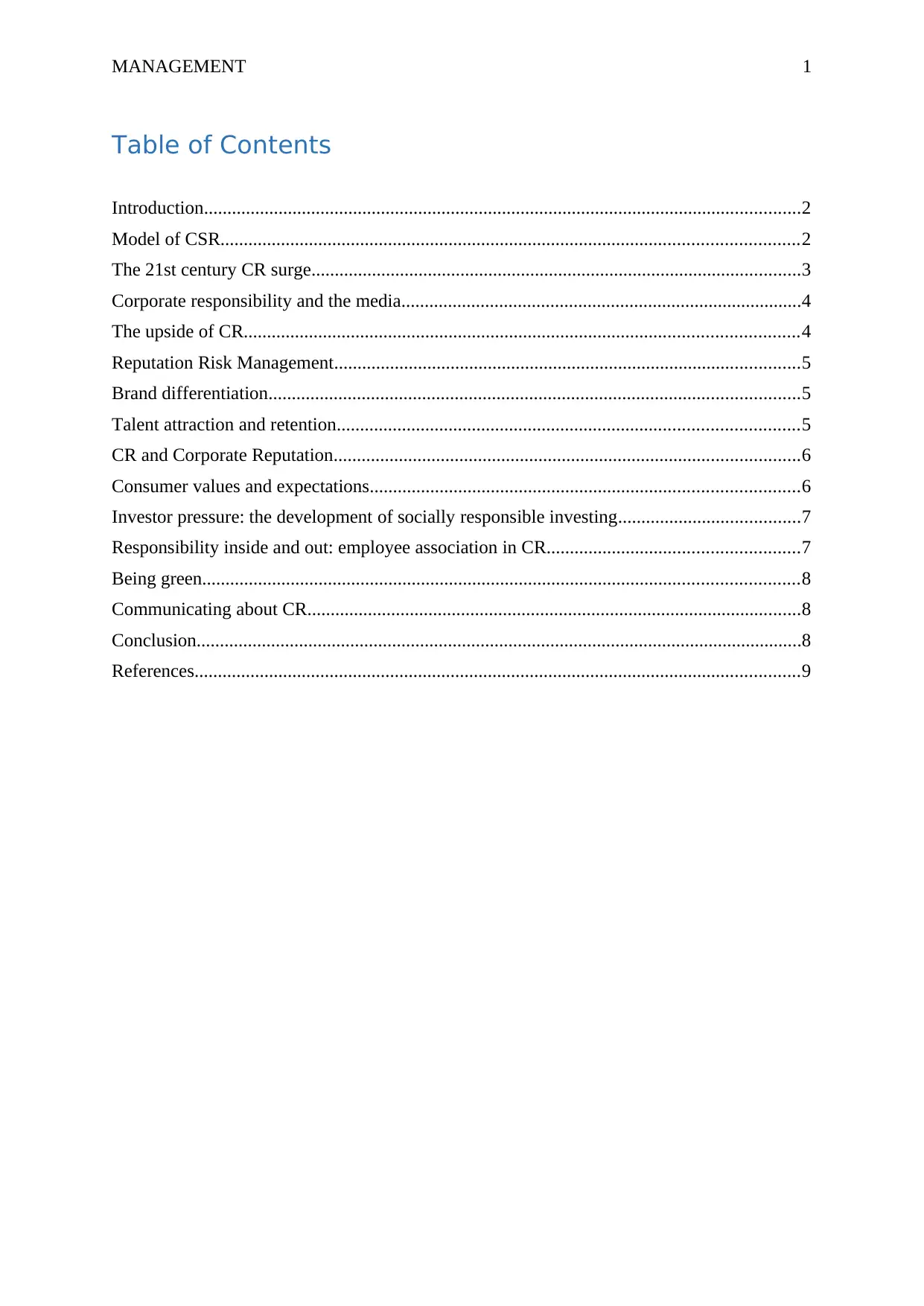
MANAGEMENT 1
Table of Contents
Introduction................................................................................................................................2
Model of CSR............................................................................................................................2
The 21st century CR surge.........................................................................................................3
Corporate responsibility and the media......................................................................................4
The upside of CR.......................................................................................................................4
Reputation Risk Management....................................................................................................5
Brand differentiation..................................................................................................................5
Talent attraction and retention...................................................................................................5
CR and Corporate Reputation....................................................................................................6
Consumer values and expectations............................................................................................6
Investor pressure: the development of socially responsible investing.......................................7
Responsibility inside and out: employee association in CR......................................................7
Being green................................................................................................................................8
Communicating about CR..........................................................................................................8
Conclusion..................................................................................................................................8
References..................................................................................................................................9
Table of Contents
Introduction................................................................................................................................2
Model of CSR............................................................................................................................2
The 21st century CR surge.........................................................................................................3
Corporate responsibility and the media......................................................................................4
The upside of CR.......................................................................................................................4
Reputation Risk Management....................................................................................................5
Brand differentiation..................................................................................................................5
Talent attraction and retention...................................................................................................5
CR and Corporate Reputation....................................................................................................6
Consumer values and expectations............................................................................................6
Investor pressure: the development of socially responsible investing.......................................7
Responsibility inside and out: employee association in CR......................................................7
Being green................................................................................................................................8
Communicating about CR..........................................................................................................8
Conclusion..................................................................................................................................8
References..................................................................................................................................9
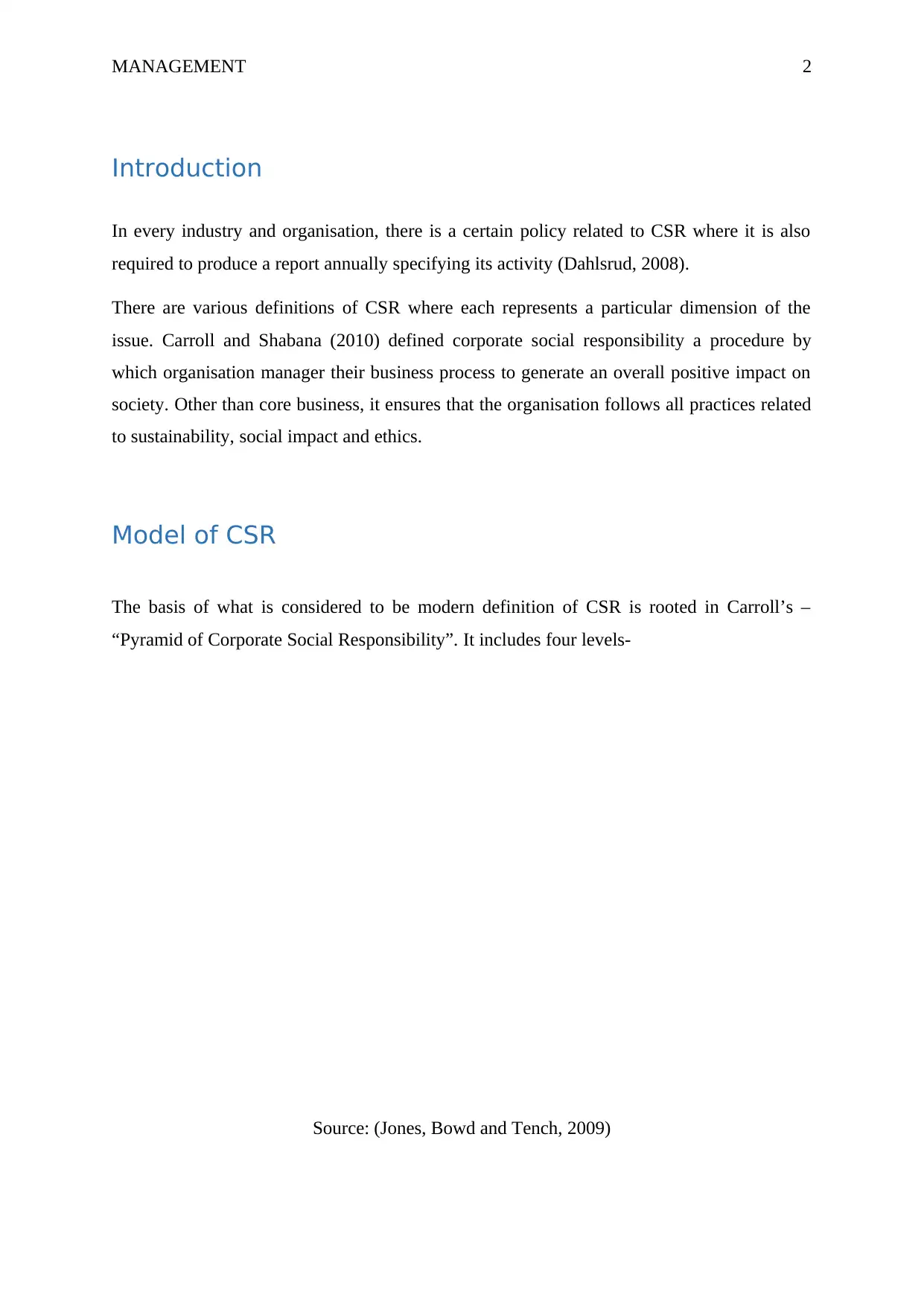
MANAGEMENT 2
Introduction
In every industry and organisation, there is a certain policy related to CSR where it is also
required to produce a report annually specifying its activity (Dahlsrud, 2008).
There are various definitions of CSR where each represents a particular dimension of the
issue. Carroll and Shabana (2010) defined corporate social responsibility a procedure by
which organisation manager their business process to generate an overall positive impact on
society. Other than core business, it ensures that the organisation follows all practices related
to sustainability, social impact and ethics.
Model of CSR
The basis of what is considered to be modern definition of CSR is rooted in Carroll’s –
“Pyramid of Corporate Social Responsibility”. It includes four levels-
Source: (Jones, Bowd and Tench, 2009)
Introduction
In every industry and organisation, there is a certain policy related to CSR where it is also
required to produce a report annually specifying its activity (Dahlsrud, 2008).
There are various definitions of CSR where each represents a particular dimension of the
issue. Carroll and Shabana (2010) defined corporate social responsibility a procedure by
which organisation manager their business process to generate an overall positive impact on
society. Other than core business, it ensures that the organisation follows all practices related
to sustainability, social impact and ethics.
Model of CSR
The basis of what is considered to be modern definition of CSR is rooted in Carroll’s –
“Pyramid of Corporate Social Responsibility”. It includes four levels-
Source: (Jones, Bowd and Tench, 2009)
⊘ This is a preview!⊘
Do you want full access?
Subscribe today to unlock all pages.

Trusted by 1+ million students worldwide
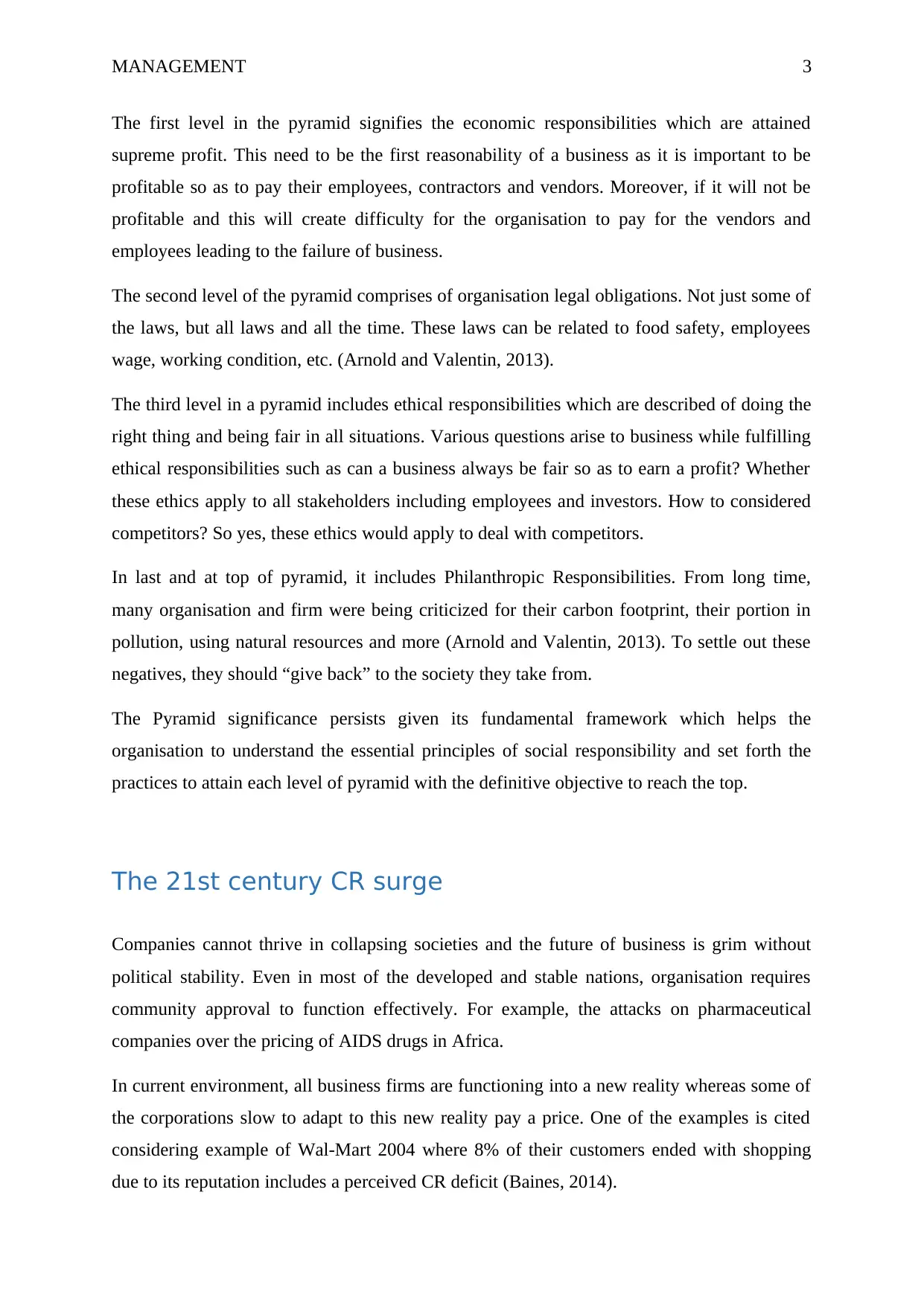
MANAGEMENT 3
The first level in the pyramid signifies the economic responsibilities which are attained
supreme profit. This need to be the first reasonability of a business as it is important to be
profitable so as to pay their employees, contractors and vendors. Moreover, if it will not be
profitable and this will create difficulty for the organisation to pay for the vendors and
employees leading to the failure of business.
The second level of the pyramid comprises of organisation legal obligations. Not just some of
the laws, but all laws and all the time. These laws can be related to food safety, employees
wage, working condition, etc. (Arnold and Valentin, 2013).
The third level in a pyramid includes ethical responsibilities which are described of doing the
right thing and being fair in all situations. Various questions arise to business while fulfilling
ethical responsibilities such as can a business always be fair so as to earn a profit? Whether
these ethics apply to all stakeholders including employees and investors. How to considered
competitors? So yes, these ethics would apply to deal with competitors.
In last and at top of pyramid, it includes Philanthropic Responsibilities. From long time,
many organisation and firm were being criticized for their carbon footprint, their portion in
pollution, using natural resources and more (Arnold and Valentin, 2013). To settle out these
negatives, they should “give back” to the society they take from.
The Pyramid significance persists given its fundamental framework which helps the
organisation to understand the essential principles of social responsibility and set forth the
practices to attain each level of pyramid with the definitive objective to reach the top.
The 21st century CR surge
Companies cannot thrive in collapsing societies and the future of business is grim without
political stability. Even in most of the developed and stable nations, organisation requires
community approval to function effectively. For example, the attacks on pharmaceutical
companies over the pricing of AIDS drugs in Africa.
In current environment, all business firms are functioning into a new reality whereas some of
the corporations slow to adapt to this new reality pay a price. One of the examples is cited
considering example of Wal-Mart 2004 where 8% of their customers ended with shopping
due to its reputation includes a perceived CR deficit (Baines, 2014).
The first level in the pyramid signifies the economic responsibilities which are attained
supreme profit. This need to be the first reasonability of a business as it is important to be
profitable so as to pay their employees, contractors and vendors. Moreover, if it will not be
profitable and this will create difficulty for the organisation to pay for the vendors and
employees leading to the failure of business.
The second level of the pyramid comprises of organisation legal obligations. Not just some of
the laws, but all laws and all the time. These laws can be related to food safety, employees
wage, working condition, etc. (Arnold and Valentin, 2013).
The third level in a pyramid includes ethical responsibilities which are described of doing the
right thing and being fair in all situations. Various questions arise to business while fulfilling
ethical responsibilities such as can a business always be fair so as to earn a profit? Whether
these ethics apply to all stakeholders including employees and investors. How to considered
competitors? So yes, these ethics would apply to deal with competitors.
In last and at top of pyramid, it includes Philanthropic Responsibilities. From long time,
many organisation and firm were being criticized for their carbon footprint, their portion in
pollution, using natural resources and more (Arnold and Valentin, 2013). To settle out these
negatives, they should “give back” to the society they take from.
The Pyramid significance persists given its fundamental framework which helps the
organisation to understand the essential principles of social responsibility and set forth the
practices to attain each level of pyramid with the definitive objective to reach the top.
The 21st century CR surge
Companies cannot thrive in collapsing societies and the future of business is grim without
political stability. Even in most of the developed and stable nations, organisation requires
community approval to function effectively. For example, the attacks on pharmaceutical
companies over the pricing of AIDS drugs in Africa.
In current environment, all business firms are functioning into a new reality whereas some of
the corporations slow to adapt to this new reality pay a price. One of the examples is cited
considering example of Wal-Mart 2004 where 8% of their customers ended with shopping
due to its reputation includes a perceived CR deficit (Baines, 2014).
Paraphrase This Document
Need a fresh take? Get an instant paraphrase of this document with our AI Paraphraser
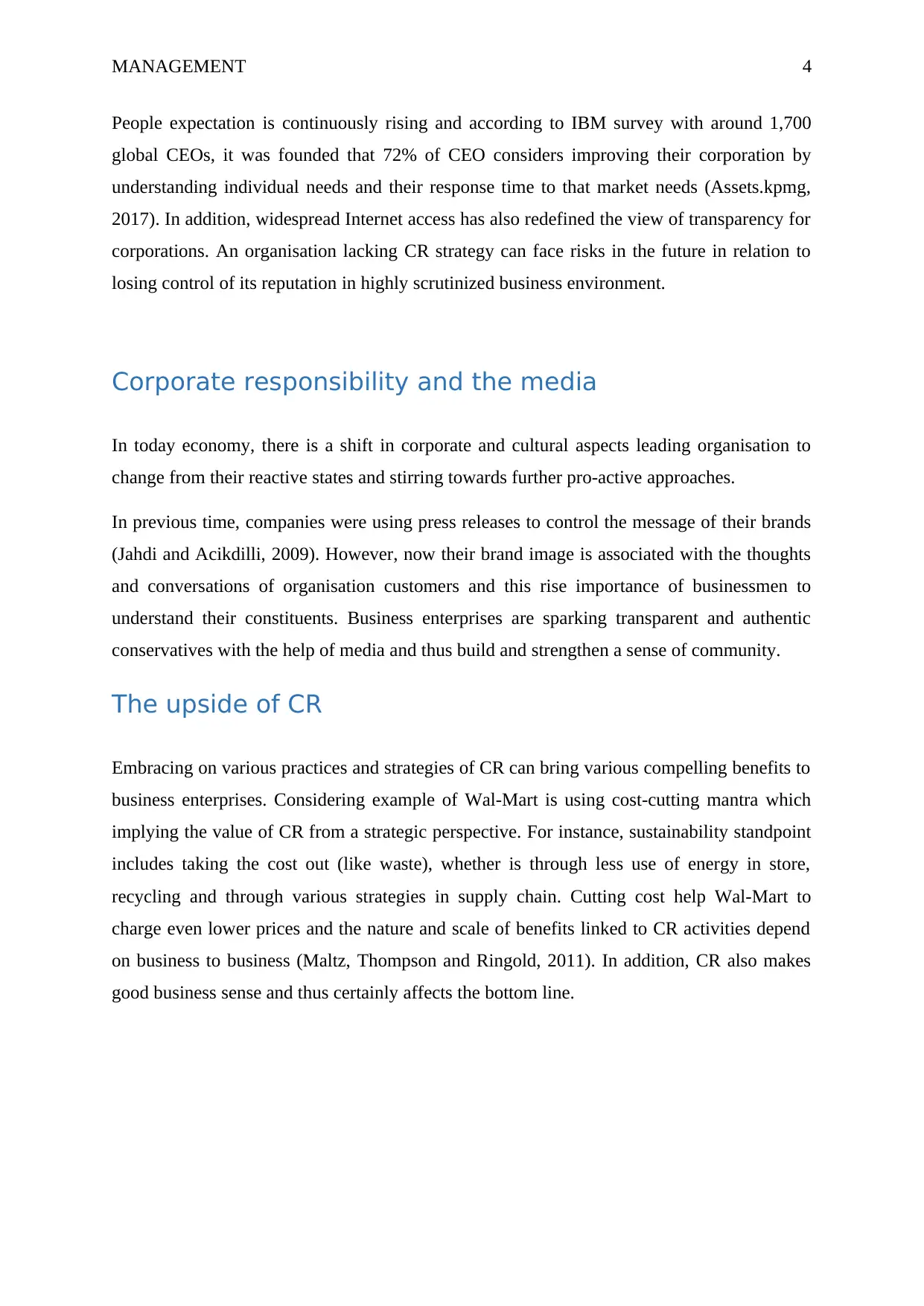
MANAGEMENT 4
People expectation is continuously rising and according to IBM survey with around 1,700
global CEOs, it was founded that 72% of CEO considers improving their corporation by
understanding individual needs and their response time to that market needs (Assets.kpmg,
2017). In addition, widespread Internet access has also redefined the view of transparency for
corporations. An organisation lacking CR strategy can face risks in the future in relation to
losing control of its reputation in highly scrutinized business environment.
Corporate responsibility and the media
In today economy, there is a shift in corporate and cultural aspects leading organisation to
change from their reactive states and stirring towards further pro-active approaches.
In previous time, companies were using press releases to control the message of their brands
(Jahdi and Acikdilli, 2009). However, now their brand image is associated with the thoughts
and conversations of organisation customers and this rise importance of businessmen to
understand their constituents. Business enterprises are sparking transparent and authentic
conservatives with the help of media and thus build and strengthen a sense of community.
The upside of CR
Embracing on various practices and strategies of CR can bring various compelling benefits to
business enterprises. Considering example of Wal-Mart is using cost-cutting mantra which
implying the value of CR from a strategic perspective. For instance, sustainability standpoint
includes taking the cost out (like waste), whether is through less use of energy in store,
recycling and through various strategies in supply chain. Cutting cost help Wal-Mart to
charge even lower prices and the nature and scale of benefits linked to CR activities depend
on business to business (Maltz, Thompson and Ringold, 2011). In addition, CR also makes
good business sense and thus certainly affects the bottom line.
People expectation is continuously rising and according to IBM survey with around 1,700
global CEOs, it was founded that 72% of CEO considers improving their corporation by
understanding individual needs and their response time to that market needs (Assets.kpmg,
2017). In addition, widespread Internet access has also redefined the view of transparency for
corporations. An organisation lacking CR strategy can face risks in the future in relation to
losing control of its reputation in highly scrutinized business environment.
Corporate responsibility and the media
In today economy, there is a shift in corporate and cultural aspects leading organisation to
change from their reactive states and stirring towards further pro-active approaches.
In previous time, companies were using press releases to control the message of their brands
(Jahdi and Acikdilli, 2009). However, now their brand image is associated with the thoughts
and conversations of organisation customers and this rise importance of businessmen to
understand their constituents. Business enterprises are sparking transparent and authentic
conservatives with the help of media and thus build and strengthen a sense of community.
The upside of CR
Embracing on various practices and strategies of CR can bring various compelling benefits to
business enterprises. Considering example of Wal-Mart is using cost-cutting mantra which
implying the value of CR from a strategic perspective. For instance, sustainability standpoint
includes taking the cost out (like waste), whether is through less use of energy in store,
recycling and through various strategies in supply chain. Cutting cost help Wal-Mart to
charge even lower prices and the nature and scale of benefits linked to CR activities depend
on business to business (Maltz, Thompson and Ringold, 2011). In addition, CR also makes
good business sense and thus certainly affects the bottom line.
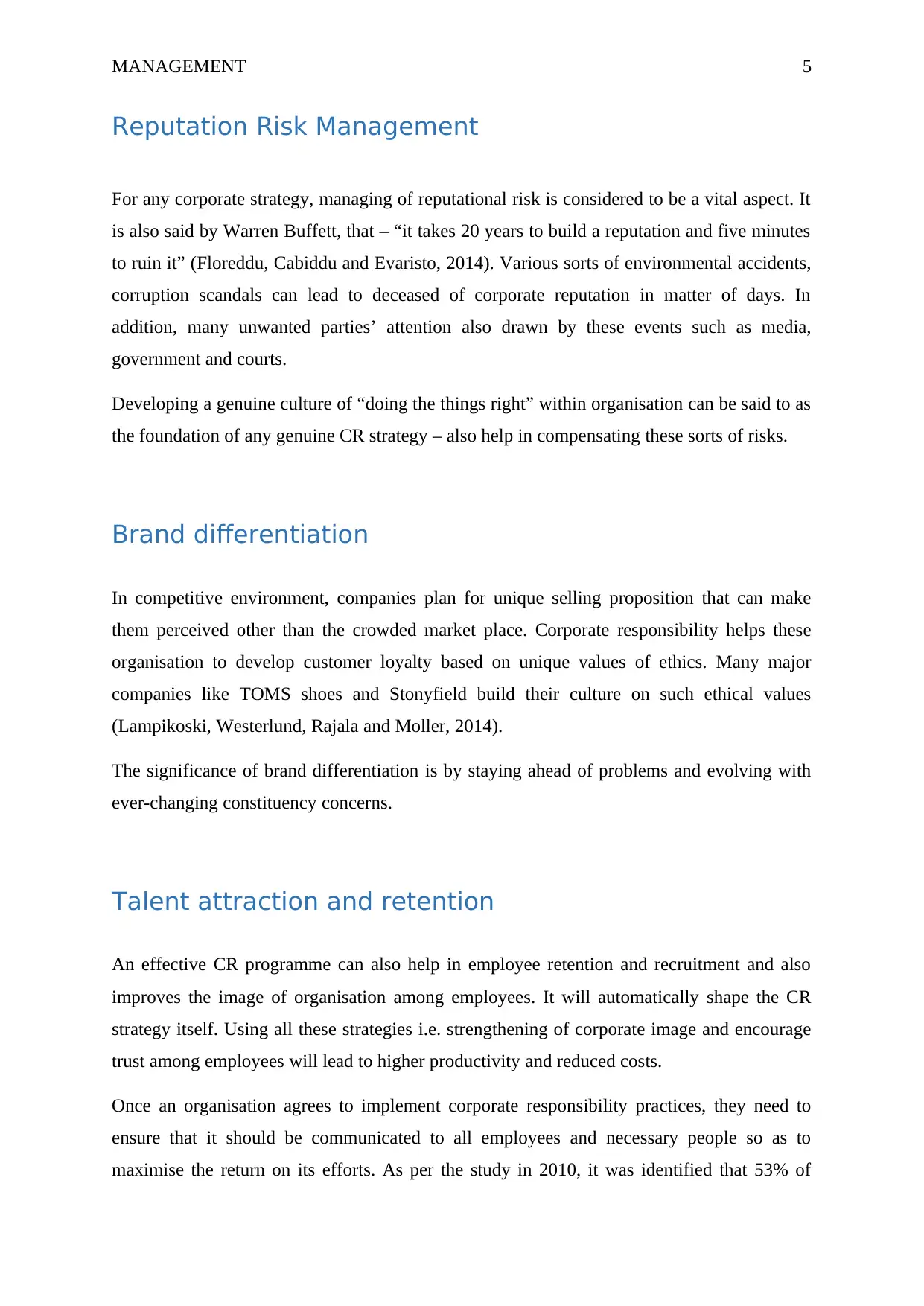
MANAGEMENT 5
Reputation Risk Management
For any corporate strategy, managing of reputational risk is considered to be a vital aspect. It
is also said by Warren Buffett, that – “it takes 20 years to build a reputation and five minutes
to ruin it” (Floreddu, Cabiddu and Evaristo, 2014). Various sorts of environmental accidents,
corruption scandals can lead to deceased of corporate reputation in matter of days. In
addition, many unwanted parties’ attention also drawn by these events such as media,
government and courts.
Developing a genuine culture of “doing the things right” within organisation can be said to as
the foundation of any genuine CR strategy – also help in compensating these sorts of risks.
Brand differentiation
In competitive environment, companies plan for unique selling proposition that can make
them perceived other than the crowded market place. Corporate responsibility helps these
organisation to develop customer loyalty based on unique values of ethics. Many major
companies like TOMS shoes and Stonyfield build their culture on such ethical values
(Lampikoski, Westerlund, Rajala and Moller, 2014).
The significance of brand differentiation is by staying ahead of problems and evolving with
ever-changing constituency concerns.
Talent attraction and retention
An effective CR programme can also help in employee retention and recruitment and also
improves the image of organisation among employees. It will automatically shape the CR
strategy itself. Using all these strategies i.e. strengthening of corporate image and encourage
trust among employees will lead to higher productivity and reduced costs.
Once an organisation agrees to implement corporate responsibility practices, they need to
ensure that it should be communicated to all employees and necessary people so as to
maximise the return on its efforts. As per the study in 2010, it was identified that 53% of
Reputation Risk Management
For any corporate strategy, managing of reputational risk is considered to be a vital aspect. It
is also said by Warren Buffett, that – “it takes 20 years to build a reputation and five minutes
to ruin it” (Floreddu, Cabiddu and Evaristo, 2014). Various sorts of environmental accidents,
corruption scandals can lead to deceased of corporate reputation in matter of days. In
addition, many unwanted parties’ attention also drawn by these events such as media,
government and courts.
Developing a genuine culture of “doing the things right” within organisation can be said to as
the foundation of any genuine CR strategy – also help in compensating these sorts of risks.
Brand differentiation
In competitive environment, companies plan for unique selling proposition that can make
them perceived other than the crowded market place. Corporate responsibility helps these
organisation to develop customer loyalty based on unique values of ethics. Many major
companies like TOMS shoes and Stonyfield build their culture on such ethical values
(Lampikoski, Westerlund, Rajala and Moller, 2014).
The significance of brand differentiation is by staying ahead of problems and evolving with
ever-changing constituency concerns.
Talent attraction and retention
An effective CR programme can also help in employee retention and recruitment and also
improves the image of organisation among employees. It will automatically shape the CR
strategy itself. Using all these strategies i.e. strengthening of corporate image and encourage
trust among employees will lead to higher productivity and reduced costs.
Once an organisation agrees to implement corporate responsibility practices, they need to
ensure that it should be communicated to all employees and necessary people so as to
maximise the return on its efforts. As per the study in 2010, it was identified that 53% of
⊘ This is a preview!⊘
Do you want full access?
Subscribe today to unlock all pages.

Trusted by 1+ million students worldwide
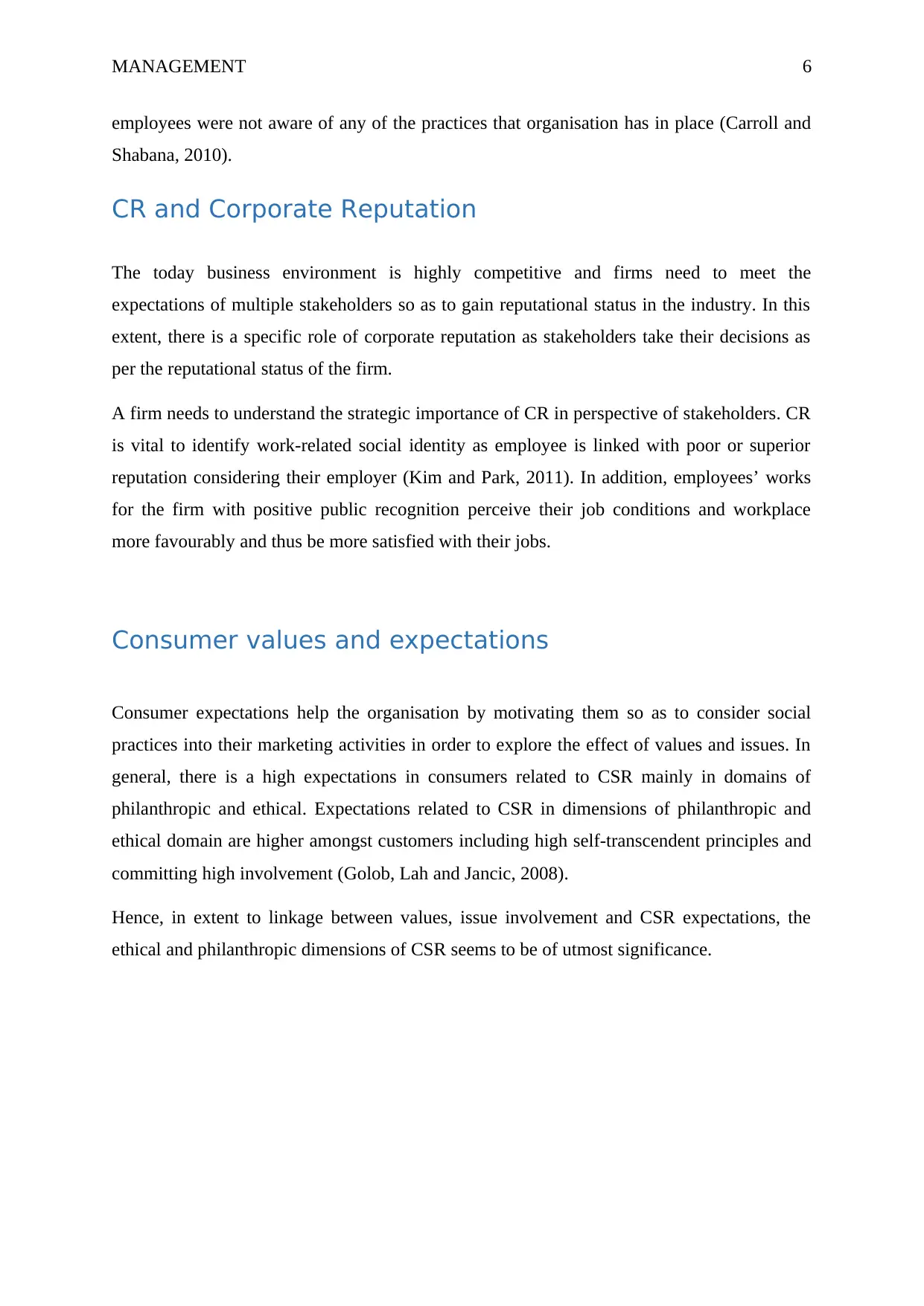
MANAGEMENT 6
employees were not aware of any of the practices that organisation has in place (Carroll and
Shabana, 2010).
CR and Corporate Reputation
The today business environment is highly competitive and firms need to meet the
expectations of multiple stakeholders so as to gain reputational status in the industry. In this
extent, there is a specific role of corporate reputation as stakeholders take their decisions as
per the reputational status of the firm.
A firm needs to understand the strategic importance of CR in perspective of stakeholders. CR
is vital to identify work-related social identity as employee is linked with poor or superior
reputation considering their employer (Kim and Park, 2011). In addition, employees’ works
for the firm with positive public recognition perceive their job conditions and workplace
more favourably and thus be more satisfied with their jobs.
Consumer values and expectations
Consumer expectations help the organisation by motivating them so as to consider social
practices into their marketing activities in order to explore the effect of values and issues. In
general, there is a high expectations in consumers related to CSR mainly in domains of
philanthropic and ethical. Expectations related to CSR in dimensions of philanthropic and
ethical domain are higher amongst customers including high self-transcendent principles and
committing high involvement (Golob, Lah and Jancic, 2008).
Hence, in extent to linkage between values, issue involvement and CSR expectations, the
ethical and philanthropic dimensions of CSR seems to be of utmost significance.
employees were not aware of any of the practices that organisation has in place (Carroll and
Shabana, 2010).
CR and Corporate Reputation
The today business environment is highly competitive and firms need to meet the
expectations of multiple stakeholders so as to gain reputational status in the industry. In this
extent, there is a specific role of corporate reputation as stakeholders take their decisions as
per the reputational status of the firm.
A firm needs to understand the strategic importance of CR in perspective of stakeholders. CR
is vital to identify work-related social identity as employee is linked with poor or superior
reputation considering their employer (Kim and Park, 2011). In addition, employees’ works
for the firm with positive public recognition perceive their job conditions and workplace
more favourably and thus be more satisfied with their jobs.
Consumer values and expectations
Consumer expectations help the organisation by motivating them so as to consider social
practices into their marketing activities in order to explore the effect of values and issues. In
general, there is a high expectations in consumers related to CSR mainly in domains of
philanthropic and ethical. Expectations related to CSR in dimensions of philanthropic and
ethical domain are higher amongst customers including high self-transcendent principles and
committing high involvement (Golob, Lah and Jancic, 2008).
Hence, in extent to linkage between values, issue involvement and CSR expectations, the
ethical and philanthropic dimensions of CSR seems to be of utmost significance.
Paraphrase This Document
Need a fresh take? Get an instant paraphrase of this document with our AI Paraphraser
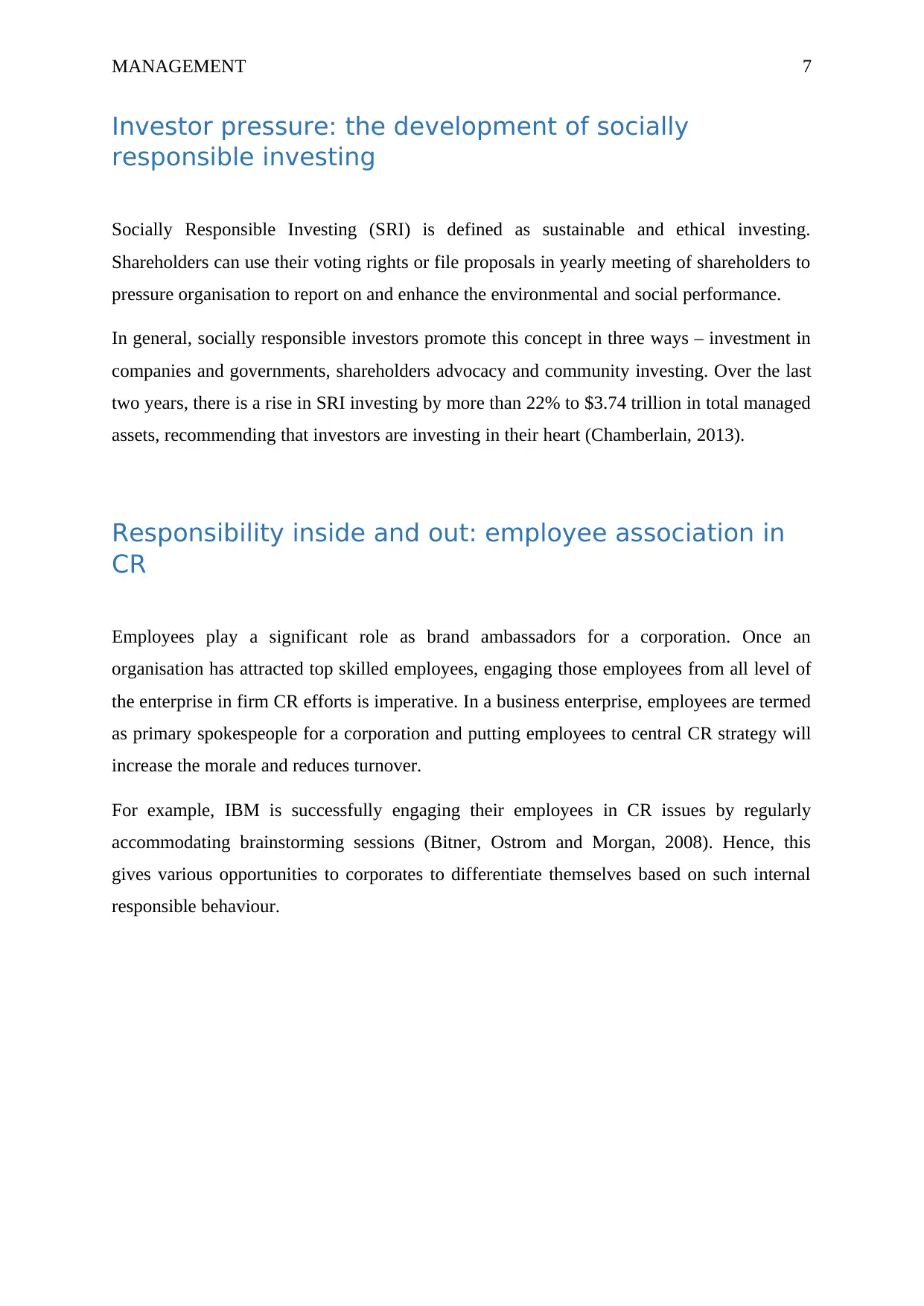
MANAGEMENT 7
Investor pressure: the development of socially
responsible investing
Socially Responsible Investing (SRI) is defined as sustainable and ethical investing.
Shareholders can use their voting rights or file proposals in yearly meeting of shareholders to
pressure organisation to report on and enhance the environmental and social performance.
In general, socially responsible investors promote this concept in three ways – investment in
companies and governments, shareholders advocacy and community investing. Over the last
two years, there is a rise in SRI investing by more than 22% to $3.74 trillion in total managed
assets, recommending that investors are investing in their heart (Chamberlain, 2013).
Responsibility inside and out: employee association in
CR
Employees play a significant role as brand ambassadors for a corporation. Once an
organisation has attracted top skilled employees, engaging those employees from all level of
the enterprise in firm CR efforts is imperative. In a business enterprise, employees are termed
as primary spokespeople for a corporation and putting employees to central CR strategy will
increase the morale and reduces turnover.
For example, IBM is successfully engaging their employees in CR issues by regularly
accommodating brainstorming sessions (Bitner, Ostrom and Morgan, 2008). Hence, this
gives various opportunities to corporates to differentiate themselves based on such internal
responsible behaviour.
Investor pressure: the development of socially
responsible investing
Socially Responsible Investing (SRI) is defined as sustainable and ethical investing.
Shareholders can use their voting rights or file proposals in yearly meeting of shareholders to
pressure organisation to report on and enhance the environmental and social performance.
In general, socially responsible investors promote this concept in three ways – investment in
companies and governments, shareholders advocacy and community investing. Over the last
two years, there is a rise in SRI investing by more than 22% to $3.74 trillion in total managed
assets, recommending that investors are investing in their heart (Chamberlain, 2013).
Responsibility inside and out: employee association in
CR
Employees play a significant role as brand ambassadors for a corporation. Once an
organisation has attracted top skilled employees, engaging those employees from all level of
the enterprise in firm CR efforts is imperative. In a business enterprise, employees are termed
as primary spokespeople for a corporation and putting employees to central CR strategy will
increase the morale and reduces turnover.
For example, IBM is successfully engaging their employees in CR issues by regularly
accommodating brainstorming sessions (Bitner, Ostrom and Morgan, 2008). Hence, this
gives various opportunities to corporates to differentiate themselves based on such internal
responsible behaviour.
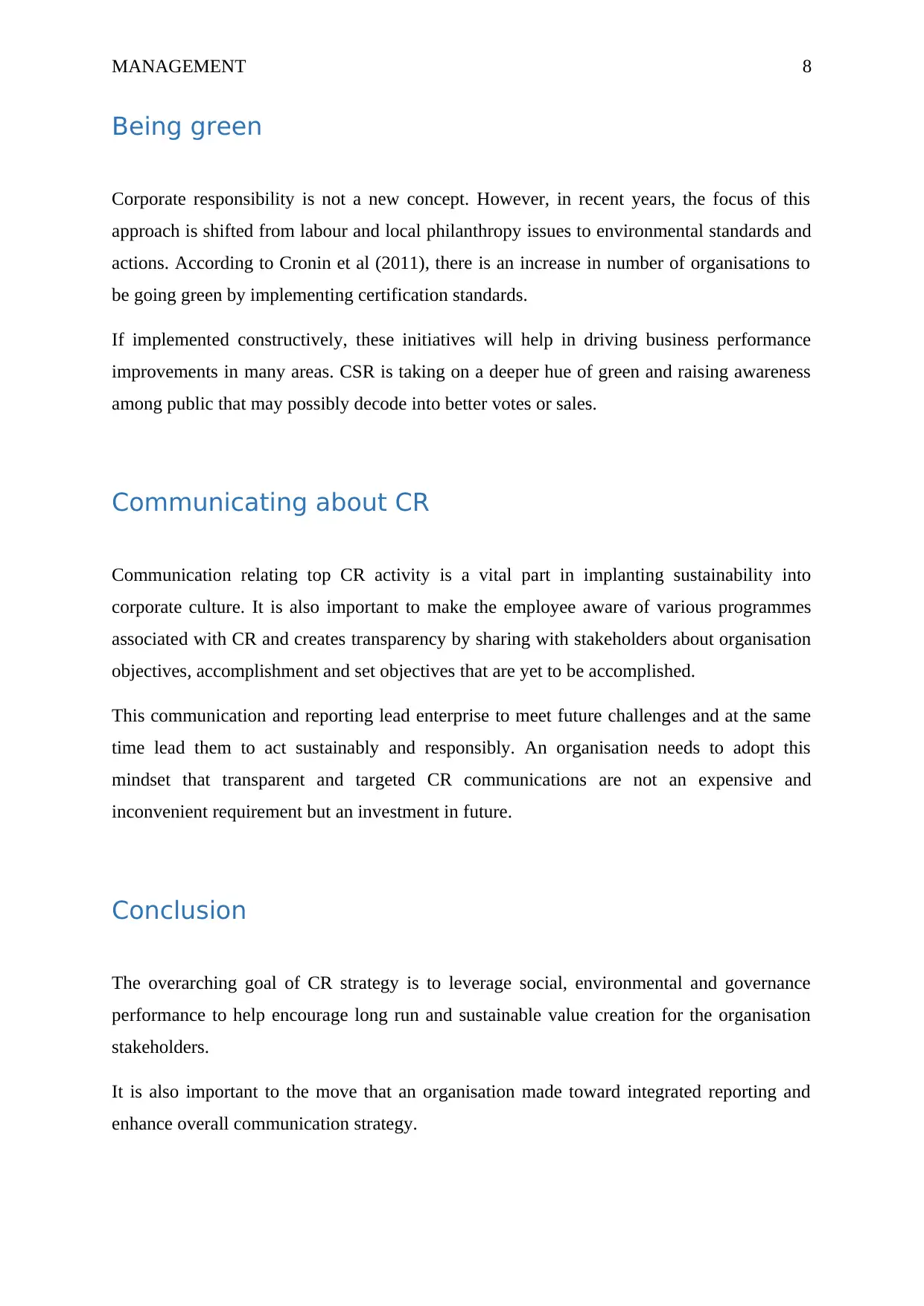
MANAGEMENT 8
Being green
Corporate responsibility is not a new concept. However, in recent years, the focus of this
approach is shifted from labour and local philanthropy issues to environmental standards and
actions. According to Cronin et al (2011), there is an increase in number of organisations to
be going green by implementing certification standards.
If implemented constructively, these initiatives will help in driving business performance
improvements in many areas. CSR is taking on a deeper hue of green and raising awareness
among public that may possibly decode into better votes or sales.
Communicating about CR
Communication relating top CR activity is a vital part in implanting sustainability into
corporate culture. It is also important to make the employee aware of various programmes
associated with CR and creates transparency by sharing with stakeholders about organisation
objectives, accomplishment and set objectives that are yet to be accomplished.
This communication and reporting lead enterprise to meet future challenges and at the same
time lead them to act sustainably and responsibly. An organisation needs to adopt this
mindset that transparent and targeted CR communications are not an expensive and
inconvenient requirement but an investment in future.
Conclusion
The overarching goal of CR strategy is to leverage social, environmental and governance
performance to help encourage long run and sustainable value creation for the organisation
stakeholders.
It is also important to the move that an organisation made toward integrated reporting and
enhance overall communication strategy.
Being green
Corporate responsibility is not a new concept. However, in recent years, the focus of this
approach is shifted from labour and local philanthropy issues to environmental standards and
actions. According to Cronin et al (2011), there is an increase in number of organisations to
be going green by implementing certification standards.
If implemented constructively, these initiatives will help in driving business performance
improvements in many areas. CSR is taking on a deeper hue of green and raising awareness
among public that may possibly decode into better votes or sales.
Communicating about CR
Communication relating top CR activity is a vital part in implanting sustainability into
corporate culture. It is also important to make the employee aware of various programmes
associated with CR and creates transparency by sharing with stakeholders about organisation
objectives, accomplishment and set objectives that are yet to be accomplished.
This communication and reporting lead enterprise to meet future challenges and at the same
time lead them to act sustainably and responsibly. An organisation needs to adopt this
mindset that transparent and targeted CR communications are not an expensive and
inconvenient requirement but an investment in future.
Conclusion
The overarching goal of CR strategy is to leverage social, environmental and governance
performance to help encourage long run and sustainable value creation for the organisation
stakeholders.
It is also important to the move that an organisation made toward integrated reporting and
enhance overall communication strategy.
⊘ This is a preview!⊘
Do you want full access?
Subscribe today to unlock all pages.

Trusted by 1+ million students worldwide
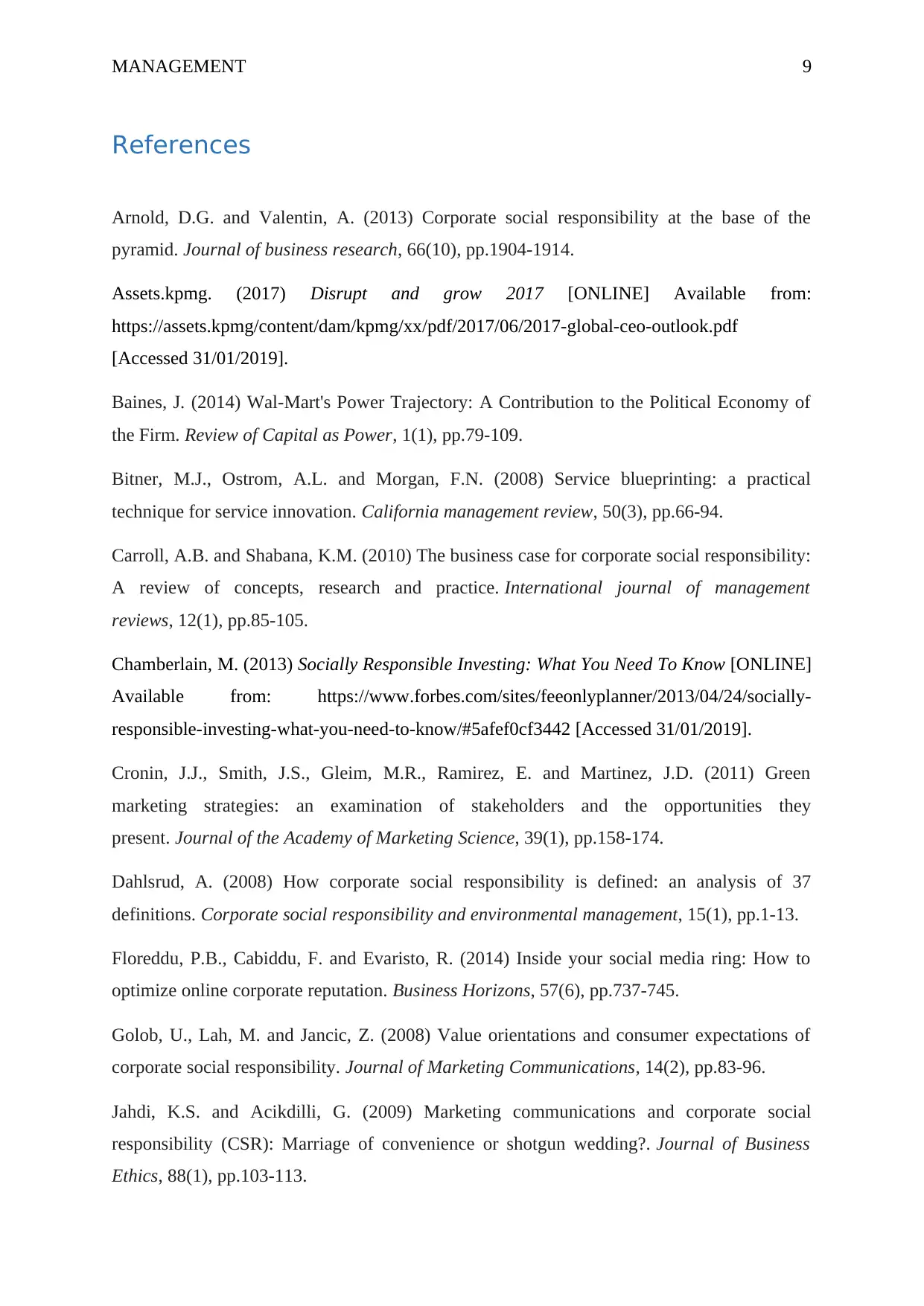
MANAGEMENT 9
References
Arnold, D.G. and Valentin, A. (2013) Corporate social responsibility at the base of the
pyramid. Journal of business research, 66(10), pp.1904-1914.
Assets.kpmg. (2017) Disrupt and grow 2017 [ONLINE] Available from:
https://assets.kpmg/content/dam/kpmg/xx/pdf/2017/06/2017-global-ceo-outlook.pdf
[Accessed 31/01/2019].
Baines, J. (2014) Wal-Mart's Power Trajectory: A Contribution to the Political Economy of
the Firm. Review of Capital as Power, 1(1), pp.79-109.
Bitner, M.J., Ostrom, A.L. and Morgan, F.N. (2008) Service blueprinting: a practical
technique for service innovation. California management review, 50(3), pp.66-94.
Carroll, A.B. and Shabana, K.M. (2010) The business case for corporate social responsibility:
A review of concepts, research and practice. International journal of management
reviews, 12(1), pp.85-105.
Chamberlain, M. (2013) Socially Responsible Investing: What You Need To Know [ONLINE]
Available from: https://www.forbes.com/sites/feeonlyplanner/2013/04/24/socially-
responsible-investing-what-you-need-to-know/#5afef0cf3442 [Accessed 31/01/2019].
Cronin, J.J., Smith, J.S., Gleim, M.R., Ramirez, E. and Martinez, J.D. (2011) Green
marketing strategies: an examination of stakeholders and the opportunities they
present. Journal of the Academy of Marketing Science, 39(1), pp.158-174.
Dahlsrud, A. (2008) How corporate social responsibility is defined: an analysis of 37
definitions. Corporate social responsibility and environmental management, 15(1), pp.1-13.
Floreddu, P.B., Cabiddu, F. and Evaristo, R. (2014) Inside your social media ring: How to
optimize online corporate reputation. Business Horizons, 57(6), pp.737-745.
Golob, U., Lah, M. and Jancic, Z. (2008) Value orientations and consumer expectations of
corporate social responsibility. Journal of Marketing Communications, 14(2), pp.83-96.
Jahdi, K.S. and Acikdilli, G. (2009) Marketing communications and corporate social
responsibility (CSR): Marriage of convenience or shotgun wedding?. Journal of Business
Ethics, 88(1), pp.103-113.
References
Arnold, D.G. and Valentin, A. (2013) Corporate social responsibility at the base of the
pyramid. Journal of business research, 66(10), pp.1904-1914.
Assets.kpmg. (2017) Disrupt and grow 2017 [ONLINE] Available from:
https://assets.kpmg/content/dam/kpmg/xx/pdf/2017/06/2017-global-ceo-outlook.pdf
[Accessed 31/01/2019].
Baines, J. (2014) Wal-Mart's Power Trajectory: A Contribution to the Political Economy of
the Firm. Review of Capital as Power, 1(1), pp.79-109.
Bitner, M.J., Ostrom, A.L. and Morgan, F.N. (2008) Service blueprinting: a practical
technique for service innovation. California management review, 50(3), pp.66-94.
Carroll, A.B. and Shabana, K.M. (2010) The business case for corporate social responsibility:
A review of concepts, research and practice. International journal of management
reviews, 12(1), pp.85-105.
Chamberlain, M. (2013) Socially Responsible Investing: What You Need To Know [ONLINE]
Available from: https://www.forbes.com/sites/feeonlyplanner/2013/04/24/socially-
responsible-investing-what-you-need-to-know/#5afef0cf3442 [Accessed 31/01/2019].
Cronin, J.J., Smith, J.S., Gleim, M.R., Ramirez, E. and Martinez, J.D. (2011) Green
marketing strategies: an examination of stakeholders and the opportunities they
present. Journal of the Academy of Marketing Science, 39(1), pp.158-174.
Dahlsrud, A. (2008) How corporate social responsibility is defined: an analysis of 37
definitions. Corporate social responsibility and environmental management, 15(1), pp.1-13.
Floreddu, P.B., Cabiddu, F. and Evaristo, R. (2014) Inside your social media ring: How to
optimize online corporate reputation. Business Horizons, 57(6), pp.737-745.
Golob, U., Lah, M. and Jancic, Z. (2008) Value orientations and consumer expectations of
corporate social responsibility. Journal of Marketing Communications, 14(2), pp.83-96.
Jahdi, K.S. and Acikdilli, G. (2009) Marketing communications and corporate social
responsibility (CSR): Marriage of convenience or shotgun wedding?. Journal of Business
Ethics, 88(1), pp.103-113.
Paraphrase This Document
Need a fresh take? Get an instant paraphrase of this document with our AI Paraphraser
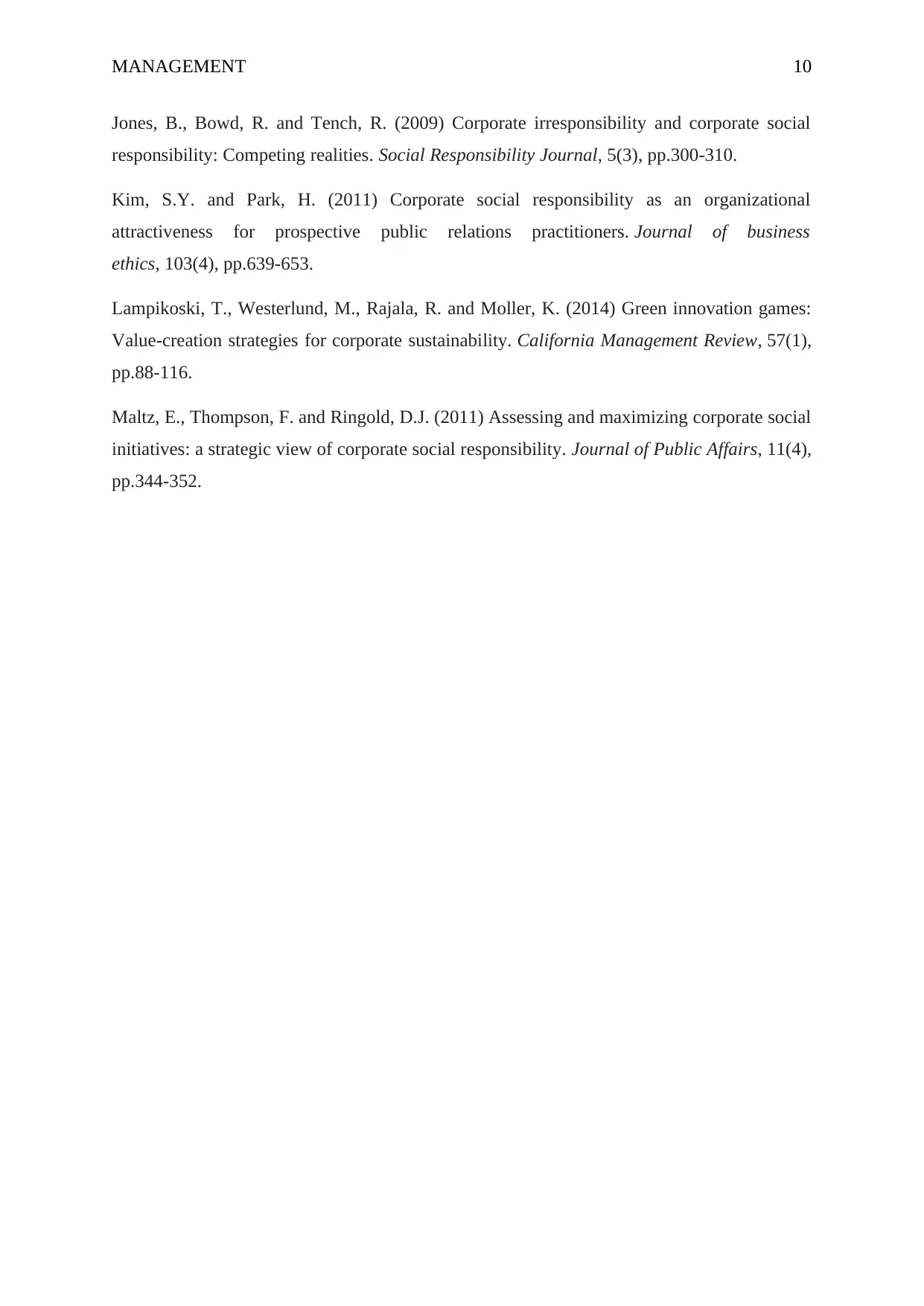
MANAGEMENT 10
Jones, B., Bowd, R. and Tench, R. (2009) Corporate irresponsibility and corporate social
responsibility: Competing realities. Social Responsibility Journal, 5(3), pp.300-310.
Kim, S.Y. and Park, H. (2011) Corporate social responsibility as an organizational
attractiveness for prospective public relations practitioners. Journal of business
ethics, 103(4), pp.639-653.
Lampikoski, T., Westerlund, M., Rajala, R. and Moller, K. (2014) Green innovation games:
Value-creation strategies for corporate sustainability. California Management Review, 57(1),
pp.88-116.
Maltz, E., Thompson, F. and Ringold, D.J. (2011) Assessing and maximizing corporate social
initiatives: a strategic view of corporate social responsibility. Journal of Public Affairs, 11(4),
pp.344-352.
Jones, B., Bowd, R. and Tench, R. (2009) Corporate irresponsibility and corporate social
responsibility: Competing realities. Social Responsibility Journal, 5(3), pp.300-310.
Kim, S.Y. and Park, H. (2011) Corporate social responsibility as an organizational
attractiveness for prospective public relations practitioners. Journal of business
ethics, 103(4), pp.639-653.
Lampikoski, T., Westerlund, M., Rajala, R. and Moller, K. (2014) Green innovation games:
Value-creation strategies for corporate sustainability. California Management Review, 57(1),
pp.88-116.
Maltz, E., Thompson, F. and Ringold, D.J. (2011) Assessing and maximizing corporate social
initiatives: a strategic view of corporate social responsibility. Journal of Public Affairs, 11(4),
pp.344-352.
1 out of 11
Related Documents
Your All-in-One AI-Powered Toolkit for Academic Success.
+13062052269
info@desklib.com
Available 24*7 on WhatsApp / Email
![[object Object]](/_next/static/media/star-bottom.7253800d.svg)
Unlock your academic potential
Copyright © 2020–2025 A2Z Services. All Rights Reserved. Developed and managed by ZUCOL.





